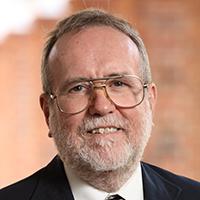Innovation at UVA: Some Thoughts on Ideas
Launching a concept toward the creation, development, and introduction of a useful product or method does “take a village,” according to George T. Gillies, who explains how this process looks at the University of Virginia. Mr. Gillies is a research professor of mechanical and biomedical engineering in UVA’s School of Engineering and Applied Science.
I am approaching the end of my career. I have been on the faculty of the School of Engineering and Applied Science for almost 35 years and, during that time, have been privileged to work on a number of new medical and engineering technologies with colleagues in every department of that School, as well as from several of the clinical departments in the School of Medicine, and the basic science departments of the College and Graduate School of Arts and Sciences..
 How does a concept for a new medical device or surgical tool come to life? Is it due to just one brilliant flash of light in an inventor’s mind? Or maybe because many years of a doctor’s clinical practice finally reveal a solution to a problem? Might it possibly be because a young student totally unfamiliar with the field hears a lecture and, not burdened by ingrained dogma, simply looks at things a different way? In my experience, the answer is yes, yes, and yes. There are likely as many ways to conceive a new device or method as there are people who think about it. Why, then, do relatively few new concepts make it all the way to the marketplace, if there are so many possibilities for innovation? Here too, there are several answers. The most obvious, of course, is that not all (or even most) ideas turn out in the end to be “good” ones, in terms of workability, uniqueness and, ultimately, economic viability. Lack of funding and other resources for early stage development and testing can pose insurmountable roadblocks. Still other reasons include difficult regulatory hurdles, various barriers to adoption of the device or method, and concerns over the robustness of the intellectual property.
How does a concept for a new medical device or surgical tool come to life? Is it due to just one brilliant flash of light in an inventor’s mind? Or maybe because many years of a doctor’s clinical practice finally reveal a solution to a problem? Might it possibly be because a young student totally unfamiliar with the field hears a lecture and, not burdened by ingrained dogma, simply looks at things a different way? In my experience, the answer is yes, yes, and yes. There are likely as many ways to conceive a new device or method as there are people who think about it. Why, then, do relatively few new concepts make it all the way to the marketplace, if there are so many possibilities for innovation? Here too, there are several answers. The most obvious, of course, is that not all (or even most) ideas turn out in the end to be “good” ones, in terms of workability, uniqueness and, ultimately, economic viability. Lack of funding and other resources for early stage development and testing can pose insurmountable roadblocks. Still other reasons include difficult regulatory hurdles, various barriers to adoption of the device or method, and concerns over the robustness of the intellectual property.
While there are many classic cases of heroic inventors like Thomas Edison almost single-handedly overcoming these limits and bringing a light bulb into common use around the world, We are so fortunate here that our “Academical Village” provides us with each of the necessary elements for this to happen. With a thriving student body, a faculty keen for exploration, and all of the support services needed for research, development, and technology transfer, the University has achieved a “critical mass” that allows the region, the nation, and the world to benefit from the ever growing number of fresh new ideas that come into existence here each year. Moreover, while it is always challenging to carry out the entrepreneurial tasks of forming and growing a start-up company based on a new concept, that route is now being pursued successfully by an ever greater number of UVA faculty and students right here in Charlottesville.
In the end, this has been made possible by the presence within one institution of deep scientific, technical, and medical expertise in the College, the School of Engineering and Applied Science, and the School of Medicine. The many joint programs now available for initiating interdisciplinary exploratory research across the Grounds has brought about a literal eruption of new ideas, many of which have gone from the seed stage to that of substantial external financial support. But that is just the start. The experienced guidance on commercialization strategies available from the Darden School of Business and the McIntire School of Commerce, the skilled intellectual property and technology transfer work of the Licensing and Ventures Group, and the careful oversight of complex compliance issues by the Office of the Vice President for Research are all invaluable resources for any such activities.
None of this has come into existence overnight. The past three decades have seen steady, directed growth and evolution towards this new era, and it has been a privilege for me, my colleagues, and students to participate in several of the initiatives and programs that have led to it. From the present vantage point, the opportunities to solve huge scientific, medical, and societal problems are now literally there for the taking. And in the end, it all just starts with a good idea.
- A Revolution in the Air: The Wright Brothers Take to the Sky on December 17, 1903
- Musings on National Violin Day
- Making the Promise Real: How a UN Tax Convention Can Fulfill the UNDHR’s Vision
- UVA Club of Atlanta: Virtual Pilates Class
- Virginia Club of New York: Annual Book Club Planning Meeting
- UVA Club of New Orleans: Hoo-liday Party

